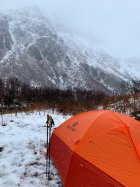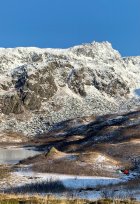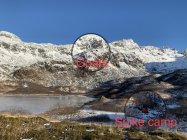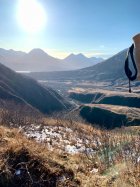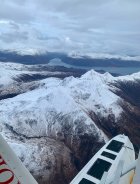Dave Way
Enjoy this site? Become a member.
So a few years ago, I decided I wanted to challenge myself to a tough hunt after I turned 60. About 15 years earlier, I took a beautiful Dall’s Sheep on what was the most difficult hunt I had ever done. In the meantime my sheep guide had bought out an outfitter who guided for Kodiak Island Mountain Goats. It seemed like a perfect fit and it was.
I booked the hunt for the earliest slot which was 2024. I would be 61. I was really looking forward to this challenge. Then this spring I received a call and was offered a cancellation hunt slot for this season. I accepted the offer and sent the deposit. Shortly after that I drew a very difficult tag for Goulds Turkey in Arizona. I had been applying for six years to draw one of only eight nonresident tags given out each year. I had already lost a bunch of weight and was walking up to 8 miles a day so everything seemed to be falling into place. I figured these would be my last guided hunts.
Well sometimes life throws you curve balls… Less than a month after sending deposits on both hunts, I was diagnosed with Prostate Cancer. This really messed up my training plans. I shortened up my turkey hunt to get back to have surgery the day after I returned. I was fortunate enough to harvest a Gobbler on day one.

Now my focus turned to the mountain goat hunt in Alaska. Recovery from the surgery really put a kink in my training plans. Still determined to pull off this hunt, I ordered in some really high-quality mountaineering boots. I learned from that Dall Sheep hunt, that footwear is an absolute key, so I was not going to make a mistake like I did years ago. Eventually, I was able to start training again. In the meantime, I was securing other ultralight high-quality gear necessary for this hunt. The plan was to leave main camp and set up a spike camp at elevation, so the weight of all my gear was critical. Eventually I learned that the surgery was successful and I was cancer free. That gave me a real boost and I started pushing myself harder.
By the time the hunt neared, I had put 102 miles on my boots. I was hiking up the steepest terrain I could find. Eventually, the hills became easier and easier. All of my other gear, clothing, sleeping bag, rain gear etc. had been acquired. Everything was again on track. Then another curve ball…
Three weeks before the hunt, my father, who was in a nursing home, fell and broke his hip. Less than a week later, he passed away. My siblings arrived, and we planned out the funeral. The service was on a Sunday, and the following Saturday, I left for Alaska. I was rather torn about this decision, but thought maybe it was for the best to get away and just reflect.
After several flights, I arrived at Kodiak Island Alaska. If you’ve never hunted, Alaska, the weather dictates everything. I had to stay at the hotel, two extra days, because the float planes simply could not fly due to high winds. I was frustrated but knew this was a possibility. Finally, the winds died down and we were able to make the flight in. The trip in was in a De Havilland Beaver float plane.
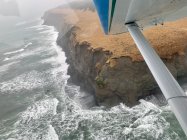
We arrived at base camp and unloaded everything on the beach. I had done this before but the difference this time was that everything had to be coordinated based not only on weather conditions, but also high and low tides, since Kodiak is in the Pacific Ocean. This was something I really never thought about before leaving, but it added to the overall experience.
Now it was time to head to spike camp. We needed to take everything in that we would need for up to several days. After crossing the bay in a boat, they called “leaky”, seeing seals and otters on the way, we started our 3-4 mile hike. These goats are unique since they are at low altitude 2,000-2,500’. Then again you start at sea level so there is still plenty of vertical involved in getting to them.

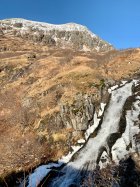
We started the hike in thick Alders on trails the Brown Bears used as evidenced by their scat and huge tracks. The ground was soft and very treacherous. As we moved inland, we started following a dry creek, bed. At places we could hear the water flowing below the gravel, but there was not enough melt off or rain to have water flowing at the surface. This was rather difficult traveling through the brush, gravel and boulders, but eventually we had climbed about 1500 feet and reached the snow line.
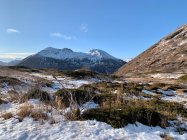
I booked the hunt for the earliest slot which was 2024. I would be 61. I was really looking forward to this challenge. Then this spring I received a call and was offered a cancellation hunt slot for this season. I accepted the offer and sent the deposit. Shortly after that I drew a very difficult tag for Goulds Turkey in Arizona. I had been applying for six years to draw one of only eight nonresident tags given out each year. I had already lost a bunch of weight and was walking up to 8 miles a day so everything seemed to be falling into place. I figured these would be my last guided hunts.
Well sometimes life throws you curve balls… Less than a month after sending deposits on both hunts, I was diagnosed with Prostate Cancer. This really messed up my training plans. I shortened up my turkey hunt to get back to have surgery the day after I returned. I was fortunate enough to harvest a Gobbler on day one.

Now my focus turned to the mountain goat hunt in Alaska. Recovery from the surgery really put a kink in my training plans. Still determined to pull off this hunt, I ordered in some really high-quality mountaineering boots. I learned from that Dall Sheep hunt, that footwear is an absolute key, so I was not going to make a mistake like I did years ago. Eventually, I was able to start training again. In the meantime, I was securing other ultralight high-quality gear necessary for this hunt. The plan was to leave main camp and set up a spike camp at elevation, so the weight of all my gear was critical. Eventually I learned that the surgery was successful and I was cancer free. That gave me a real boost and I started pushing myself harder.
By the time the hunt neared, I had put 102 miles on my boots. I was hiking up the steepest terrain I could find. Eventually, the hills became easier and easier. All of my other gear, clothing, sleeping bag, rain gear etc. had been acquired. Everything was again on track. Then another curve ball…
Three weeks before the hunt, my father, who was in a nursing home, fell and broke his hip. Less than a week later, he passed away. My siblings arrived, and we planned out the funeral. The service was on a Sunday, and the following Saturday, I left for Alaska. I was rather torn about this decision, but thought maybe it was for the best to get away and just reflect.
After several flights, I arrived at Kodiak Island Alaska. If you’ve never hunted, Alaska, the weather dictates everything. I had to stay at the hotel, two extra days, because the float planes simply could not fly due to high winds. I was frustrated but knew this was a possibility. Finally, the winds died down and we were able to make the flight in. The trip in was in a De Havilland Beaver float plane.

We arrived at base camp and unloaded everything on the beach. I had done this before but the difference this time was that everything had to be coordinated based not only on weather conditions, but also high and low tides, since Kodiak is in the Pacific Ocean. This was something I really never thought about before leaving, but it added to the overall experience.
Now it was time to head to spike camp. We needed to take everything in that we would need for up to several days. After crossing the bay in a boat, they called “leaky”, seeing seals and otters on the way, we started our 3-4 mile hike. These goats are unique since they are at low altitude 2,000-2,500’. Then again you start at sea level so there is still plenty of vertical involved in getting to them.


We started the hike in thick Alders on trails the Brown Bears used as evidenced by their scat and huge tracks. The ground was soft and very treacherous. As we moved inland, we started following a dry creek, bed. At places we could hear the water flowing below the gravel, but there was not enough melt off or rain to have water flowing at the surface. This was rather difficult traveling through the brush, gravel and boulders, but eventually we had climbed about 1500 feet and reached the snow line.

Last edited:










